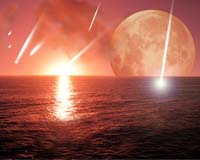| . |  |
. |
MOffett Feild CA (SPX) Sep 10, 2009 When planet Earth was just cooling down from its fiery creation, the sun was faint and young. So faint that it should not have been able to keep the oceans of Earth from freezing. But fortunately for the creation of life, water was kept liquid on our young planet. For years scientists have debated what could have kept Earth warm enough to prevent the oceans from freezing solid. Now a team of researchers from Tokyo Institute of Technology and University of Copenhagen's Department of Chemistry have coaxed an explanation out of ancient rocks, as reported in the journal PNAS
A perfect greenhouse gas "Carbonyl sulphide is and was the perfect greenhouse gas. Much better than carbon dioxide. We estimate that a blanket of carbonyl sulphide would have provided about 30 percent extra energy to the surface of the planet, and that would have compensated for what was lacking from the sun," says Johnson.
Strange distribution "There is really no process in the rocky mantle of Earth that would explain this distribution of isotopes," says Johnson. "You would need something happening in the atmosphere." Painstaking experimentation helped the researchers find a likely atmospheric process. By irradiating sulphur dioxide with different wavelengths of sunlight, they observed that sunlight passing through carbonyl sulphide gave them the wavelengths that produced the weird isotope mix. "Shielding by carbonyl sulphide is really a pretty obvious candidate once you think about it, but until we looked, everyone had missed it," says Johnson. "What we found is really an archaic analogue to the current ozone layer, a layer that protects us from ultraviolet radiation. But unlike ozone, carbonyl sulphide would also have kept the planet warm. The only problem is, it didn't stay warm."
Life caused Ice Age Johnson and his co-workers created a computer model of the ancient atmosphere. In conjunction with laboratory experiments, the model suggests that the fall in carbonyl sulphide and rise of sulphate aerosols taken together would have been responsible for creating Snowball Earth, the planet-wide Ice Age hypothesised to have taken place near the end of the Archean era 2.5 billion years ago. The implications to Johnson are alarming. "Our research indicates that the distribution and composition of atmospheric gasses swung the planet from a state of life-supporting warmth to a planet-wide Ice Age spanning millions of years. I can think of no better reason to be extremely cautious about the amounts of greenhouse gasses we are currently emitting to the atmosphere." Share This Article With Planet Earth
Related Links Tokyo Institute of Technology University of Copenhagen's Department of Chemistry Explore The Early Earth at TerraDaily.com
 The Greenhouse Gas That Saved The World
The Greenhouse Gas That Saved The WorldCopenhagen, Denmark (SPX) Aug 26, 2009 When Planet Earth was just cooling down from its fiery creation, the sun was faint and young. So faint that it should not have been able to keep the oceans of earth from freezing. But fortunately for the creation of life, water was kept liquid on our young planet. For years scientists have debated what could have kept earth warm enough to prevent the oceans from freezing solid. Now a team ... read more |
|
| The content herein, unless otherwise known to be public domain, are Copyright 1995-2009 - SpaceDaily. AFP and UPI Wire Stories are copyright Agence France-Presse and United Press International. ESA Portal Reports are copyright European Space Agency. All NASA sourced material is public domain. Additional copyrights may apply in whole or part to other bona fide parties. Advertising does not imply endorsement,agreement or approval of any opinions, statements or information provided by SpaceDaily on any Web page published or hosted by SpaceDaily. Privacy Statement |